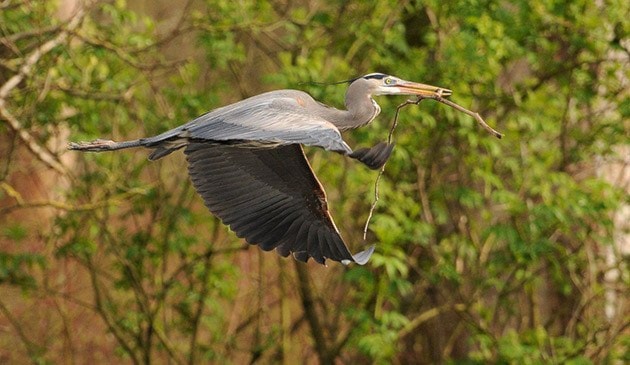The herons are back.
And just like the balmy spring weather in the Fraser Valley, their return was a little bit earlier than usual.
“They arrived two weeks early this year,” Janet Hutchinson said, while leading the first interpretive walk at the Great Blue Heron Nature Reserve on a recent Saturday morning.
“When they come back, it’s because there is lots of food for them,” she explained. And they haven’t come from very far off. Unlike the Fraser Valley’s other popular aviator, the bald eagle, great blue herons don’t migrate. Instead, they disperse to nearby areas within the region for the winter. But they always return to their mating nests in the spring.
Last year, there were 165 active nests at the reserve, which is considered a large colony by most standards. But many of the nests were damaged or lost completely in January during the winter storm that toppled trees with high winds and frigid temperatures.
This year, the number is closer to 125, Hutchinson said.
“Every year they come back to their nests and rebuild, or construct new ones,” she said, looking up into the morning sun as it filtered through the cottonwoods. Part of rebuilding those nests also serves as an important mating ritual. Herons take on a new partner every mating season. The male herons find sticks to build up the nests, and carry them into the colony to their female mates.
“We’ll see some stick-carrying behaviour today,” she said.
Sure enough, high above Hutchinson and the group gathered on the Vedder trail, a heron navigates his way through the branches. A long, skinny stick hangs from his beak as he lands close to the nest, and his mate takes it from him.
But this process doesn’t always go according to plan. Moments later there’s much squawking at another nest, resulting in one heron flying off to another tree.
“That happens. And there’s the occasional bird with no partner,” Hutchinson said, as the numbers don’t always match up. There are also juvenile herons among the group who aren’t ready to mate.
Hutchinson and other volunteers at the reserve hold these walks once a month, explaining the birds’ behaviour while educating the public on how to behave while interacting with nature.
The birds are here early because their food supply was ready for them early, she said.
While coast great blue herons are almost solely fishermen, the Fraser Valley herons have a much more varied diet.
“They’ll eat voles, fish, amphibians, snakes, gophers, dragonflies,” she said. “Fishing is their main occupation at the coast, but here they’ll eat anything they can catch.”
There are other differences, too. The B.C. subspecies of great blue heron are “just a bit smaller and darker” than herons in other regions.
One of the most interesting facts to learn along the heron walk is how the eagles and herons co-habitate the area, even though the eagle predates on the heron.
An eagle’s nest sits almost in the centre of the colony. It’s identifiable by its large mass, built up in the crook off a large tree. Heron nests, on the other hand, are scattered throughout the trees, with many to a tree. They drip with sticks and seem as if a light breeze could send them flying.
Eagles prey on the eggs and the young herons. But eagles also keep other predators at bay and will naturally defend their territory. So while the herons may sacrifice a few of their young each year to their resident pair of eagles, the overall loss is lower than when the eagles leave, Hutchinson explained.
Just a few weeks ago, bobcats were spotted in the area, with a young cat climbing a tree. Raccoons will climb the trees and scoop out eggs from unattended nests, too.
The herons will be nesting until July, and there are three more interpretive walks planned, on April 4, May 2 and June 6, at 10 a.m.
To see the herons on any other day, park at the Great Blue Heron Reserve at 5200 Sumas Prairie Road and walk along the dike to the west of the parking lot. The heron colony is high in the cottonwoods on the left, and it’s about a 15 minute walk roundtrip. The walk is wheelchair and stroller friendly, and dogs are required to be on leash.
For more information, phone 604-823-6603 or visit chilliwackblueheron.com.
jpeters@theprogress.com

